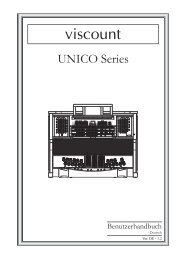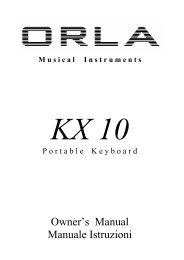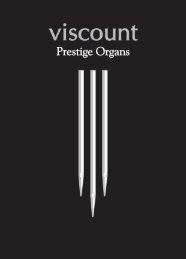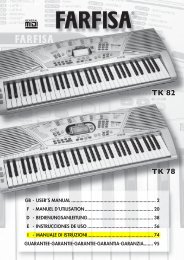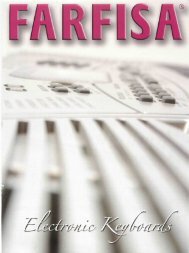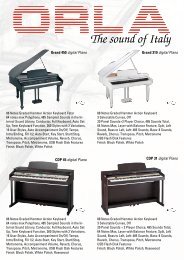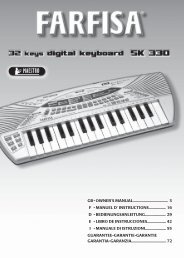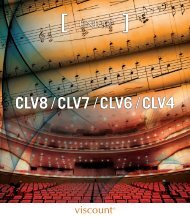Create successful ePaper yourself
Turn your PDF publications into a flip-book with our unique Google optimized e-Paper software.
<strong>Viscount</strong> Vivace 90 - 90 Deluxe<br />
Owner’s Manual<br />
MEANTONE<br />
- 8 pure major thirds: E flat - G / B flat - D / F - A / C - E / G - B / D - F # / A - C# / E - G.<br />
- 4 unusable major thirds (diminished fourths): B - D# / F# - A# / C# - E# / A flat - C.<br />
- 1 fifth known as the “wolf” (very dissonant extended fifth): A flat - E flat.<br />
- Highly irregular chromatic scale (meaning that chromatic compositions are given a very distinctive voice)<br />
- Keys usable with this temperament: C maj. / D maj. / G maj. / A maj. / B flat maj. and the relative minors.<br />
The temperaments which follow allow all the major and minor keys to be used, although those with the most alterations have<br />
a highly distinctive voice, in contrast with the modern equal temperament.<br />
WERCKMEISTER<br />
This temperament, invented by the organist and musical theorist Andreas Werckmeister, is recommended for performing the<br />
German musical repertoire of the late 1600s.<br />
KIRNBERGER<br />
This temperament, developed by Johann Philipp Kirnberger, pupil of J.S. Bach, is also suitable for playing the German<br />
baroque composers and the works of Bach.<br />
PYTHAGOREAN<br />
In this temperament, all the fifths are natural except for the “wolf” fifth, in the interval A flat - E flat, which is greatly<br />
diminished.<br />
It dates from the Middle Ages up to the 15th century, and can therefore be used for compositions of that period.<br />
VALLOTTI<br />
This Italian temperament invented by Francescantonio Vallotti was later taken up in England by Thomas Young. It can be<br />
used effectively for the Italian 18th Century repertoire, and also for the English repertoire of the same period.<br />
3.2 AN INTRODUCTION TO THE INSTRUMENT’S SETUP FUNCTIONS<br />
Pressing the [MENU] piston in the third manual panel accesses the menu containing all the organ’s setup<br />
functions. The first video page displayed is as follows:<br />
scroll the cursor downwards using the [FIELD ] button to display the second part of the menu:<br />
The display options are:<br />
o<br />
VOICES: setup functions for all the organ’s voices, such as loading of alternative voices and volume<br />
adjustment.<br />
56



